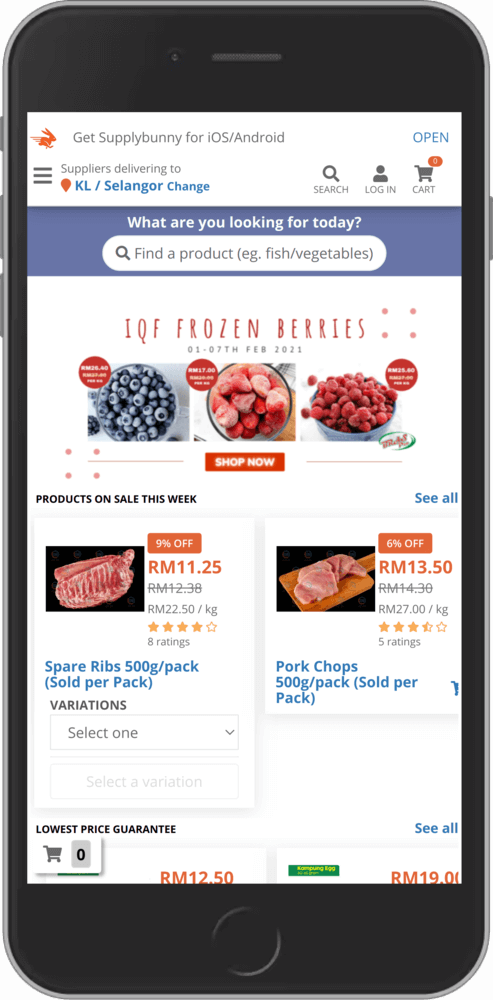Food Market Hub and Supplybunny Announce Partnership to Empower F&B Businesses
We are excited to announce an official partnership between www.foodmarkethub.com and www.supplybunny.com, two leading platforms in the food procurement industry. (0)
Supplies ordering platform for HORECA
| Buyers | Suppliers | Monthly GMV | Cloud cost |
|---|---|---|---|
| 12k | 350 | 6 figures | $150 |
Original version was built over approximately two weeks to include supplier onboarding and product search. It's continuously been improved upon for the past ~4 years to include a very wide range of features comparable to any ecommerce platform.
Rails with nginx and MySQL. Sidekiq runs the queue, redis is for caching, elasticsearch for search. Front-end was originally Backbone.js but has been migrated to Vue. Stats run off MongoDB.

We are excited to announce an official partnership between www.foodmarkethub.com and www.supplybunny.com, two leading platforms in the food procurement industry. (0)
One of the first challenges a first time-founder encounters is having to do data analysis.In the course of building Supplybunny we tried to make decisions based on data as much ... (1351)
One of my pet peeves are useless file names. If software generates a file then it will eventually need to be found. File names that are just strings of numbers that make sense o... (146)
Supplybunny was featured in DigitalNewsAsia.com for our response to the pandemic: With business hit by Covid-19, Supplybunny turns on a pin to chart rapid growth. (28)
ACO is definitely not out of reach of any organization that could benefit from it. But, because it's quite a specialized tool neighboring on academia, the real challenge is knowing that it exists in the first place. (726)
It spun out of a separate project that aimed to track FMCG trends that ultimately failed. However, through the analysis of visitors to that platform we realized a need for a platform for ingredients in particular for long-tail consumers.
Early split-testing was crucial for us to understand the type of users we’re serving. Mixpanel and the gem split were used extensively to nail-down the process needed since we were in a niche where direct checkout was often impossible. A balance was needed between allowing users to buy products directly and allowing suppliers to cancel every single order.
Supplybunny is able to preform disproportionately well compared to it’s devops cost which involves only $150 in cloud spend to support the main site as well as a smaller mirror staging set up.
Supplybunny closed $300k in funding from Gobi partners. Subsequently MAVCAP provided debt+ funding.
As with any startup data is very important but for operations as well as reporting and Supplybunny includes a comprehensive reporting dashboard that has a flexible filtering dashboard (described in a blog post) that has over 160 different calculations presented in an interface that allows for easy comparison over time.
It also has a flexible cohort reporting that measures not only recurrence but other metrics such as average basket size.
Supplybunny integrates with several APIs including three different payment processors. Originally we started out with Paypal because that was the quickest to approve even with low limits. Now Adyen and Ipay88 are used. Adyen mostly for credit cards in order to make use of tokenization. Ipay88 is crucial in order to support direct bank debit that’s so widely used in Malaysia.
It also recently integrated with a third party logistics provider in order to get accurate shipping estimates and to automatically created deliveries for orders.
It has a self-documenting REST API that’s consumed by an iOS and an Android application. It was built in Grape. It automatically generates detailed Swagger documentation.
Care was paid to it’s SEO and it outranks much bigger ecommerce sites and in some cases even suppliers’ official sites. This was mostly achieved through experience with my affiliate site and through periodic Lighthouse reviews.
Even though I worked on it alone I enforced code quality standards using reek, rubocop and rails_best_practices. Security was ensured through period reviews using brakeman with no vulnerabilities reported.
Since I was alone I haven’t ever set up CI/CD although I did deploy very frequently, often on a daily basis.
Deployment was set up using capistrano. The server was set up using an ansible script.